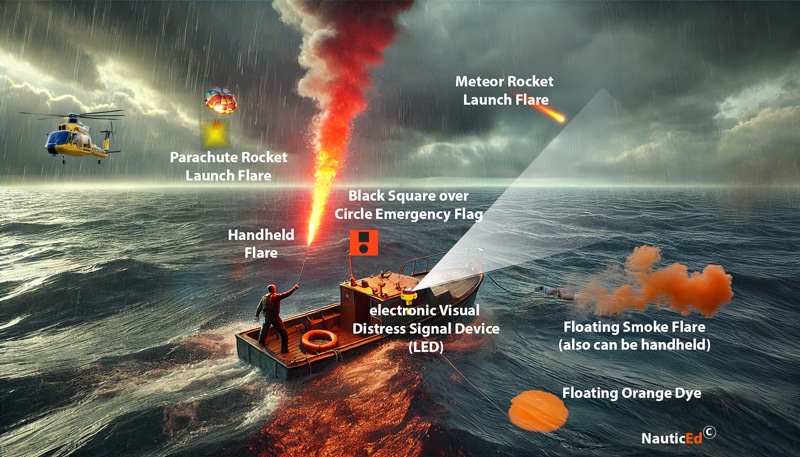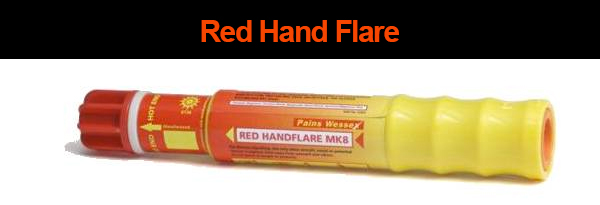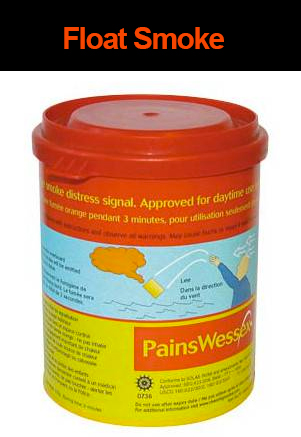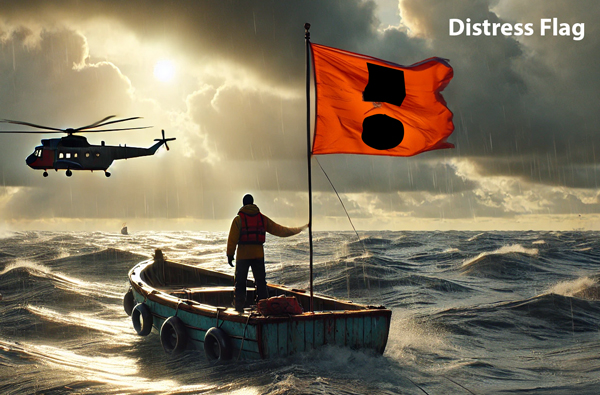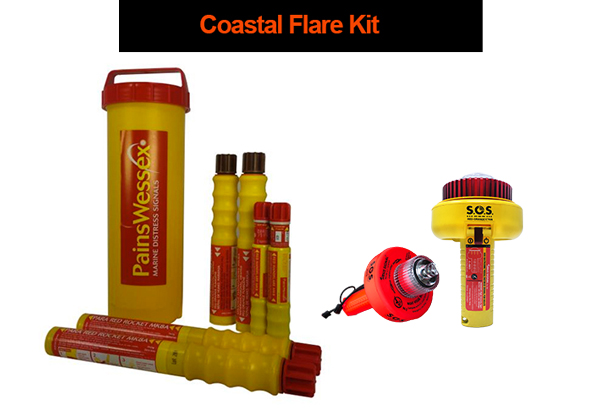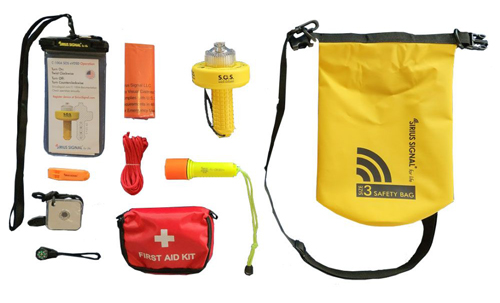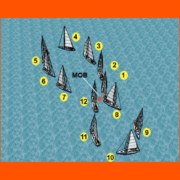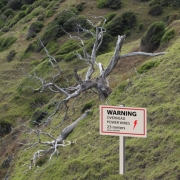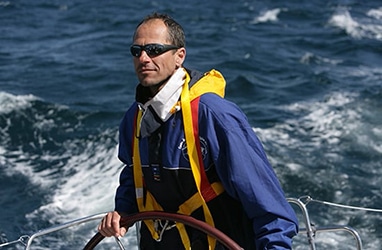
This article is an excerpt from NauticEd’s online Skipper Large Keelboats Course, a comprehensive online sailing course for beginner to intermediate sailors to learn how to sail large sailboats 26 ft (8m) and above. The Skipper Large Keelboats course is part of the Skipper Course Bundle of online courses, also teaching you how to master maneuvering under power and docking!
You can learn to sail and improve your sailing with NauticEd, the international leader in sailing education.
Essential Safety Equipment – Flares
This guy is taking nothing to chance – he is setting everything off. Hmmm, not a bad idea when you’re in serious trouble.
Flares are divided into two groups: Pyrotechnic (burning) and non-pyrotechnic.
Pyrotechnic Flares
Below is a video created by our friend Chuck Hawley. Watch it – it is a great summary of pyrotechnic flares and usage. You should check your local country’s rules for the requirements for carrying flares mentioned in this video. Also note that the laws have changed since this video allowing electronic Flares (eVDSDs).
Most likely, it is the law that you have the appropriate non-expired flares on board in your operating waterway.
Flares Video
A bit of important basic information first:
Read the instructions on all flares and always store a set of protective flare gloves in the flare container to protect your hands when setting off flares. Keep all flares in a watertight container. Flares have a shelf life; remember to check their date stamps. Don’t look directly at the flare when it is going off. Hold at arm’s length. When possible, only knowledgeable and experienced persons should use the flares.
- NEVER activate marine flares in a non-emergency situation on or near regulated water. It is illegal.
- NEVER dispose of flares in household trash.
- CONTACT your local fire department or Coast Guard about disposal. These entities may take them and use for training exercises.
Types of Pyrotechnic Flares
Pyrotechnic Flares come in many different types for different alerting requirements:
- Red Handheld Flares
A short-range distress signal is used to pinpoint position during the day or night. It burns with a light intensity of 15,000 candela for a duration of 60 seconds. Hold over the side of the boat and downwind to stop red-hot sparks falling onto your vessel. Visibility is about 3 miles (5km) at water level but 12 miles (20 km) at night – with clear conditions)
- Orange Hand Held Smoke Flares
This handheld signal produces a dense orange smoke for daylight distress signaling only. Ideal to indicate wind direction to rescue helicopters in land or sea rescues. Burning time is 60 seconds.
- Float Smoke Flares
This is a small and compact distress signal for daylight use only. There is a smoke signal that floats on the water for position marking during rescue operations. Indicates wind direction. Safe for use on oil or fuel-covered water.
- White Collision Flares
White handheld flares are for day and night use as a short-range collision warning signal and also for illuminating small areas.
- Red Rocket Flares
Longer range than a handheld, it ejects a red flare on a parachute at 1,000 feet (300 meters), burning for 40 seconds at 30,000 candelas. This gives the flare around 30 miles of visibility, allowing vessels over the horizon and out of the line of sight to potentially see your distress signal. Point the flare downwind. Fire a second flare a minute or so after your first. This gives the observer a chance to confirm the sighting and gain a bearing on your location. Don’t fire rocket flares when aircraft are in the vicinity.
Non-Pryrotechnic Devices
- LED Flares (electronic Visual Distress Signal Device (eVDSD))
LED (light) Flares are now approved as legal and are an allowed flare type for nighttime use. They should not be considered as replacements for other flare types because each flare type has a specific use but they should absolutely be considered as a necessary part of your flare kit. The major advantages of LED flares are: they can display a flashing SOS signal for hours on end; can be mounted on the boat so that it does not need to be held by a hand – allowing the person to help with other onboard happenings such as preparing to abandon ship; are reusable.
See this video by Sirius
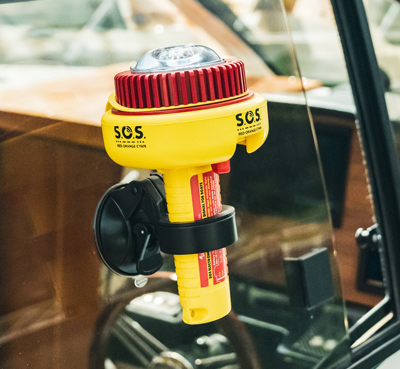
- Distress Flag
A distress flag is at least 3ft by 3ft (1m x 1m) is orange with a black square over a black circle. It (obviously) is used as a day signal only. Thought should be put into how to display it most promemntly when it will be needed. It can be run up the mast but it is possible that an amateur viewer does not recognize this as a distress signal. It is more noticeable when waved attached to a pole or paddle.
Flare Kits
A flare and distress kit should be on your boat and inspected annually.
Pyrotechnic devices should be stored in a cool, dry place and in a watertight red, orange, or yellow container prominently marked “DISTRESS SIGNALS” or “FLARES”.
- Offshore Flare Kit
These will usually contain 4 collisions, 4 red handhelds, 4 rockets, 2 smoke flares, and an eVDSD (SOS LED).
- Coastal Flare Kits
These will usually contain 2 red handhelds, 2 rockets, 2 smoke flares, and an eVDSD (SOS LED).
- Inshore Flare Kits
- These will usually contain 2 red handheld, 2 smoke flares, and an eVDSD (SOS LED).
Distress Signaling Kits
In addition to your flare kit, you should have on board a distress signaling kit. It should contain a mirror (which has been consistently proven to attract attention to far away viewers), an eVDSD (electronic Visual Distress Signal Device) which is an LED SOS signaling device discussed above, a whistle, a distress orange flag, and a floating LED flashlight – all stowed in a loudly marked bag for easy grab.
This is a Distress signaling kit created by Sirius Signal – the makers of SOS LED flares
Partnership Alliance
NauticEd has made a safety partnership alliance with Sirius Signal whereby NauticEd students can get a discount off Distress Signaling Kits and LED SOS flares as well as FREE USA shipping. See the discount here.
Sign up for a free account at NauticEd and enjoy the benefits while you learn to be a stronger boater.
You can learn more in the Skipper Course....
Knowledge and theory for longer distances and overnight sailing in diverse conditions. The Skipper Course is a comprehensive online sailing course for beginner to intermediate sailors wanting to learn how to sail larger sailboats 26ft to 56ft. Or upgrade to the Skipper Course Bundle of online courses to also master maneuvering under power and docking!

